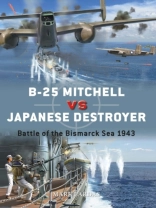Throughout the first year of the war in the Pacific during World War II the USAAF was relatively ineffective against ships. Indeed, warships in particular proved to be too elusive for conventional medium-level bombing. High-level attacks wasted bombs, and torpedo attacks required extensive training. But as 1942 closed, the Fifth Air Force developed new weapons and new tactics that were not just effective, they were deadly. A maintenance officer assigned to a B-25 unit found a way to fill the bombardier’s position with four 0.50-cal machine guns and strap an additional four 0.50s to the sides of the bomber, firing forward. Additionally, skip-bombing was developed. This called for mast-top height approaches flying the length of the target ship. If the bombs missed the target, they exploded in the water close enough to crush the sides. The technique worked perfectly when paired with strafe B-25s.Over the first two months of 1943, squadrons perfected these tactics. Then, in early March, Japan tried to reinforce their garrison in Lae, New Guinea, with a 16-ship convoy eight transports guarded by eight destroyers. The Fifth Air Force pounced on the convoy in the Bismarck Sea. By March 5 all eight transports and four destroyers had been sunk This volume examines the mechanics of skip-bombing combined with a strafing B-25, assessing the strengths and weaknesses of the combatants (B-25 versus destroyer), and revealing the results of the attacks and the reasons why these USAAF tactics were so successful.
Mark Lardas
B-25 Mitchell vs Japanese Destroyer [PDF ebook]
Battle of the Bismarck Sea 1943
B-25 Mitchell vs Japanese Destroyer [PDF ebook]
Battle of the Bismarck Sea 1943
Mua cuốn sách điện tử này và nhận thêm 1 cuốn MIỄN PHÍ!
Ngôn ngữ Anh ● định dạng PDF ● Trang 80 ● ISBN 9781472845207 ● Nhà xuất bản Bloomsbury Publishing ● Được phát hành 2021 ● Có thể tải xuống 3 lần ● Tiền tệ EUR ● TÔI 7928115 ● Sao chép bảo vệ Adobe DRM
Yêu cầu trình đọc ebook có khả năng DRM












